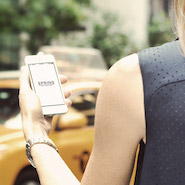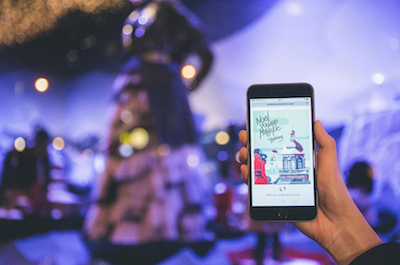- About
- Subscribe Now
- New York,
February 3, 2015

 Promotional image for Spring app
Promotional image for Spring app
Despite increased investments, luxury beauty, fashion and jewelry brands are still missing opportunities to appropriately integrate mobile into their overall digital strategy, according to a new report from L2.
The convenience, accessibility and independence that mobile allows has resulted in affluent consumers, especially “emerging affluents,” embracing the “low touch luxury” approach for product purchases and preliminary research. But, L2’s “Mobile & Luxury 2015: Insight Report” found that although mobile is increasingly important for luxury brands, many have limited strategies for digital that do not create a consistent branded experience for consumers across platforms.
“Consumers are increasingly using multiple devices to research and purchase products, and expect consistency in site functionalities and brand experience across platforms,” said Eleanor Powers, director, Insight Reports, at L2, New York. “Because of the higher levels of mobile device use among affluent consumers, luxury brands especially need to lay the groundwork for being able to fulfill these expectations.
“Sometimes it is hard to remember just how fast the ascendency of mobile has been, so it is not surprising that there is a lag period for luxury brands’ investments in their mobile sites and tablet experiences,” she said. “But that doesn’t alter the imperative of responding to evolving consumer expectations."
Device advice
L2 found that the more affluent a consumer is, the more likely they are to own, and rely, on their mobile devices. With one out of three affluent consumers using mobile devices during the path to purchase, brands must ensure a consistent experience across platforms.
Of Emerging Affluents, categorized as consumers with a household income of $75,000 to $99,000 ages 18 to 39-years old, 86 percent own a smartphone and 50 percent have a tablet. Among Hyper Affluents, those with a household income less than $250,000, 87 percent own smartphones and 69 percent have a tablet.
Tablet user
Smartphone use trumps tablet use for researching products and prices over a week’s time with 69 percent of Emerging Affluents and 56 percent of Hyper Affluents using smartphones for research. Forty-four percent of both consumer sects used their tablet for research purposes.
To this effect, luxury brands across categories increased investment in mobile-optimized Web sites between 2013 and 2014. Beauty marketers have maintained the lead in mobile-optimization with jewelers and watchmakers lagging behind.
Likewise, more than two-thirds of beauty and fashion brands have enabled mobile commerce while jewelers and watchmakers, given the high price of their wares, have been slow at embracing ecommerce.
The majority of mobile-optimized sites feature responsive designs that adjust across screen sizes and enable site functions with a distinct mobile URL. L2 found that beauty brands support lower levels of responsive design and swipe functionality in comparison to fashion and jewelry/watches brands, 53 percent versus 71 and 70 percent respectively, which is a reflection of beauty’s adaptation of mobile through early investments.
For instance, nearly all high-end beauty brands offer a mobile-optimized site and nearly four out of five have mobile commerce. For brands that have both desktop and mobile-optimized Web sites, L2 found that 85 percent of desktop pages are ecommerce enabled, whereas only 49 percent carry over this feature to mobile devices.
Even though 80 percent of fashion brands have developed mobile Web sites, “true parity” with desktop is lacking in terms of video content, wish lists and access to user reviews. This has resulted in fashion brands seeing poor conversions and low average order value when comparing mobile to desktop.
Fashion marketers must also keep in mind that 80 percent of mobile consumers researching on their devices want to make same day purchases. Three out of four consumers make these purchases in-stores via mobile, compared to less than 20 percent who use their device off-site.

Printemps, Burberry app
Mobile is increasing, albeit slowly, for jewelers and watchmakers with 11 brands launching mobile sites in 2014. Approximately 40 percent of these mobile sites offer commerce, while 57 percent use geotargeting to find nearby boutiques, likely used to drive in-store traffic when mobile purchasing is unavailable.
Interestingly, watchmaker Patek Philippe and silversmith Georg Jensen launched mobile-optimized sites in 2013, but have since deactivated them.
Keeping tabs on tablets
Affluent consumers are more than twice as likely to research rather than make a purchase on a tablet due to the nature of the device. Since most interactions on a tablet happen during a consumer’s downtime, a focus on browsing and product detail should be a priority.
To this effect, even though tablet mobile commerce is lower than on desktop it is higher than on mobile phones. This is a reflection of the ecommerce features on desktop sites.
Burberry mobile site
Overall, L2 found that beauty brands support tablet-specific experiences at a rate of more than 50 percent over fashion brands and double the brands in the watches and jewelry sector.
In beauty, 34 percent of beauty brands have tablet-specific user experiences with most hosting a desktop version that is not optimized for tablet use. Brands in this sector see a higher rate of ecommerce on tablets at 80 percent in comparison to 63 percent of beauty brands as a whole.
Fashion, although strong in mobile devices, lags behind beauty in terms of tablet-optimized sites. Only 21 percent of fashion brands offer a tablet-based experience but 86 percent of tablet sites do have ecommerce.
Loro Pianna tablet app
Also, a majority of brands include a store locator but only 26 percent use geolocation when consumers search for a nearby boutique.
In the watch and jewelry sector, 82 percent of brands rely on their traditional Web site to serve consumers on tablets, but these sites are predominantly tablet-friendly with the lines between the two blurred.
Apps to apps
Sessions in shopping applications increased by 174 percent in 2014 compared to a 76 percent increase for overall app usage, according to a report from Yahoo’s Flurry Analytics.
Strong usage growth for utilities and productivity apps as well as messaging and shopping apps points to how consumers are integrating apps into their everyday lives (see story).
But, only one in four beauty brands surveyed in L2’s Digital & Mobile Insight Report have a mobile app. Fifteen apps, released by 13 brands were either updated or rated in 2014 and only 10 of these have more than 10 user ratings.
Clearly, beauty apps have not yet been properly explored by brands. L2 found that the average app has a rating of 2.7, with an average of 193 compared to the Beauty Index average of 483.
Prestige beauty brands are lagging behind mass beauty marketers who have taken advantage of mobile apps with augmented reality.
For example, beauty marketer L’Oreal Paris released its Makeup Genius, a mobile app that allows consumers to virtually test beauty products.
L'Oreal Makeup Genius app
The user can create lists of her favorite products, but is unable to purchase directly through the app. Despite a lack of mobile commerce, L’Oreal’s Makeup Genius also offers the latest on beauty trends in the virtual space (see story).
In the fashion sector, mobile apps are beginning to fade with marketers concentrating more so on mobile sites and commerce.
Even though interest is shifting away from mobile apps, a third of brands offer at least one, with a fourth released in the last year. Unfortunately, 60 percent of these new apps resulted in no user ratings which renders the app invisible on the App Store, limiting the chance a consumer will come across it and download.
Of the fashion apps, only French atelier Givenchy uses a mobile app to provide ecommerce through its partnership with online retailer Net-A-Porter (see story).
Givenchy mobile commerce app
Watchmakers and jewelers are also struggling with mobile apps. Of the 15 new apps from 2014, none generated more than 10 ratings and two thirds received none at all.
Features included in the apps from within this sector were also limited. For example, only 3 percent allow for mobile commerce, compared to 39 percent of mobile sites.
As for store locators, only 36 percent of apps included the function whereas 57 percent of mobile Web sites offered geolocation. Also, only 9 percent tap into the user’s camera and only 11 percent offer in-app downloads.
Overall, L2 notes that “very few apps provide [a] compelling raison d’être.”
“Given the vast improvements in mobile site capabilities and performance, it is surprising to see how many luxury brands are still investing in mobile apps, most of which are not performing well,” Ms. Powers said.
“In most cases, this investment would be better spent on mobile sites,” she said.
Final Take
Jen King, lead reporter on Luxury Daily, New York
Share your thoughts. Click here